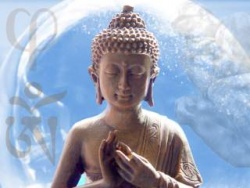The Seven Factors of Enlightenment (Bojjhanga Pabba)
I. Sati-Sambojjhanga (mindfulness)
Sati-Sambojjhanga
Mindfulness is that which watches what is occuring at the present moment in the body and mind.
To see through the third eye the reality of the moment.
II. Dhammavicaya-Sambojjhanga (investigation of the Dhamma)
Dhammavicaya-Sambojjhanga
Investigation of phenomena.
This is the wisdom or insight that can differentiate the corporal body and the mind and percieves both as imperanemt, unsatisfactory and not self.
Buddha nature
Us (student, practitioner)
Dharma (study of written word)
III. Viriya-Sambojjhanga (effort, energy)
Viriya-Sambojjhanga
This is the balanced mental effort that is generated while being mindful.
To see the impermanence of every thing and realise illusion.
IV. Piti-Sambojjhanga (explosive deep joy, happiness)
Piti-Sambojjhanga
This is the interest and lack of boredom that arises due to seeing things as they really are.
It is often associated with a feeling of lightness, lifting of the body or a thrill of joy that can make hair on the body stand up.
V. Passadhi-Sambojjhanga (tranquility, calmness)
Passadhi-Sambojjhanga
With the arising of rapture, the mind becomes calm and peaceful.
This is called tranquility.
To have a cool mind
stabilised when facing
extraordinary challenges (frightful or charming).
VI. Samadhi-Sambojjhanga (concentration)
Samadhi-Sambojjhanga
With the arising of tranquility, the mind is not distracted and no longer wanders here and there but is aware of each object that appears in the mind.
This is concentration.
Concentration:
To focus on one point,
To gather all the power
of the thoughts in one
far behind the language expression.
To be one with
the inner mind without help
of reason.
VII. Upekkha-Sambojjhanga (equanimity)
Upekkha-Sambojjhanga
With the arising of concentration, the mind sees each object in a detached and calm way.
It feels neither aversion to pain nor is it overpowered by pleasure but it is calmly and effortlessly observant of the impermanence, unsatisfactoriness or soullnessness of every constituent of body and mind.
This is called equanimity.
Not indifference
Not fatalism
But to realise
The universal illusion
Product of our six senses (the brain too)
It is intuition of
The ultimate truth




